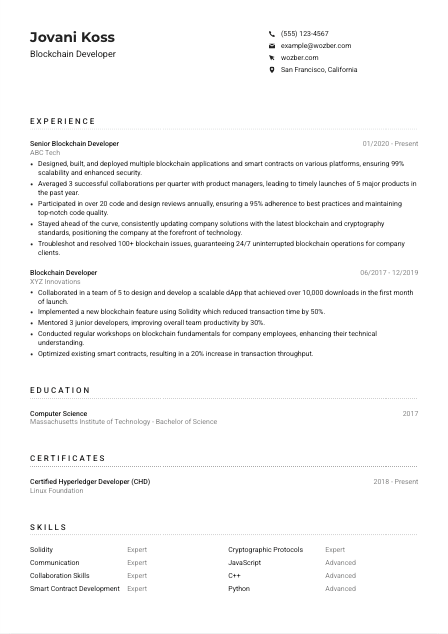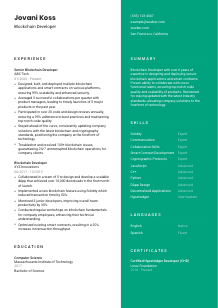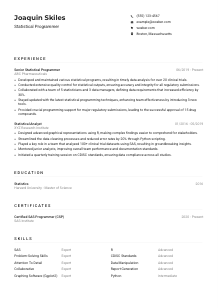Blockchain Developer Resume Example
Building decentralized ledgers, but feel your resume is stuck in central databases? Delve into this Blockchain Developer resume example, structured using Wozber free resume builder. Discover how straightforwardly you can link your distributed expertise to meet job specifics, ensuring your career blocks are always on the chain!

How to write a Blockchain Developer Resume?
Greetings, aspiring Blockchain Developer! If you're ready to distinguish yourself in the fast-evolving blockchain ecosystem, you're in the right place. Armed with detailed insights and the support of Wozber's free resume builder, you're about to craft an ATS-compliant resume that not only showcases your distributed ledger technology prowess but also tells a compelling story of your unique professional journey.
Ready to unlock the secrets to a resume that'll have hiring managers eager to meet you? Let's embark on this tailoring adventure together!
Personal Details
The journey to impress starts with personal details. It's more than just your name and contact info; it's about fine-tuning these details to create a positive first impression. Here's how to make sure your entrance is as impressive as a successful smart contract deployment.
1. Brand Yourself
Consider your name as the 'smart contract' of your resume. It should be clearly visible, legible, and memorable. Opt for a clean, bold font to ensure your name is the 'transaction' that gets 'validated' first by the hiring manager's eyes.
2. Sync with Your Desired Role
Immediately below your name, state your aspiration: "Blockchain Developer". This demonstrates your alignment with the job at hand, acting as a 'consensus' between you and the role before the 'block' of your resume is even processed.
3. Contact Protocol
For your phone number and email, think of it as your 'public and private keys': vital, unique, and error-free. Ensuring these details are correct ensures the 'transaction' of your application doesn't fail at the first hurdle.
4. Location Hash
The job specifies "San Francisco, CA" - include this to instantly show your 'network compatibility'. It's a quick win in demonstrating your readiness and eliminates any concerns about relocation latency.
5. Profile Linkage
If you have a LinkedIn profile or a GitHub repository showcasing your projects in Ethereum or Solidity, include it. This provides a direct 'node' for employers to 'ping' and explore your 'blockchain' further.
Takeaway
Your Personal Details section is the 'genesis block' of your resume. Craft it with care, ensuring everything is up-to-date and perfectly aligned with the Blockchain Developer role. A strong start sets the stage for a memorable resume journey.





Experience
In the blockchain world, your experience is the ledger that showcases your transactions. It's proof of work and an indicator of your ability to contribute to the network. Let's dive into how to list your professional milestones with precision.
- Designed, built, and deployed multiple blockchain applications and smart contracts on various platforms, ensuring 99% scalability and enhanced security.
- Averaged 3 successful collaborations per quarter with product managers, leading to timely launches of 5 major products in the past year.
- Participated in over 20 code and design reviews annually, ensuring a 95% adherence to best practices and maintaining top‑notch code quality.
- Stayed ahead of the curve, consistently updating company solutions with the latest blockchain and cryptography standards, positioning the company at the forefront of technology.
- Troubleshot and resolved 100+ blockchain issues, guaranteeing 24/7 uninterrupted blockchain operations for company clients.
- Collaborated in a team of 5 to design and develop a scalable dApp that achieved over 10,000 downloads in the first month of launch.
- Implemented a new blockchain feature using Solidity which reduced transaction time by 50%.
- Mentored 3 junior developers, improving overall team productivity by 30%.
- Conducted regular workshops on blockchain fundamentals for company employees, enhancing their technical understanding.
- Optimized existing smart contracts, resulting in a 20% increase in transaction throughput.
1. Decipher the Job Description
Like reading the documentation of a new blockchain protocol, start by dissecting the job description. Pay attention to specific technologies and methodologies mentioned. They're the 'hashes' you'll need to 'solve' in your resume.
2. List with Precision
For each role, think of it as adding a 'block' to your 'chain'. Begin with your most recent position as the 'latest block' and work backward. Include your title, the company's name, and your tenures, akin to a block's 'timestamp'.
3. Tailor Your Contributions
Craft accomplishment statements that echo the role's responsibilities. If you 'designed, built, and deployed multiple blockchain applications,' list these achievements in a way that mirrors the job's language, showing that your previous work 'transactions' are valid for this 'blockchain'.
4. Validate Your Impact
Quantify your achievements to add credibility. If a dApp you developed achieved over 10,000 downloads, mention it. Such metrics are the 'proof of stake' that validate your qualifications and effectiveness.
5. Focus on Relevance
Stick to experiences that show your proficiency in blockchain technology and software development. While peripheral skills are valuable, your resume should prioritize the 'core processes' most relevant to a Blockchain Developer.
Takeaway
Think of each experience entry as crucial data in the blockchain of your career. They collectively validate your expertise and capability. Be meticulous, honest, and ensure the data is relevant to the 'network' (employer) you wish to join.
Education
Like the genesis block in a blockchain, your educational background lays the foundation of your resume. It's where you set the stage for your expertise. Here's how to sculpt your education section to resonate with your blockchain expertise.
1. Identify Key Educational Transactions
The job demands a "Bachelor's degree in Computer Science, Software Engineering, or related field." Ensure this requirement is not just met but clearly highlighted. Like the base layer of a blockchain, it underpins everything that follows.
2. Structure Your Education Block
Keep it straightforward: list your degree, field of study, institution, and graduation year. This clean formatting ensures the information is easily digested, like a well-organized data block in a blockchain.
3. Tailor to Fit
If your degree aligns perfectly, such as a "Bachelor of Science in Computer Science," make it prominent. It shows you have the foundational 'codebase' necessary for a career in blockchain development.
4. Showcase Relevant Courses or Projects
Especially for those earlier in their careers, highlighting specific classes or projects related to blockchain or cryptography can add depth, much like how smart contracts introduce complexity and functionality to a block.
5. Highlight Continuous Learning
Blockchain technology evolves rapidly. Show your commitment to staying current by listing any continuing education efforts, be they formal courses or self-directed learning, much like how a network evolves with each new 'block' added.
Takeaway
Your education section isn't just a record of your past; it's a testament to your foundational knowledge and continual growth in the blockchain space. Let it reflect your readiness to contribute to and evolve with the industry.
Certificates
In the blockchain domain, certifications are like tokens that represent your specialized skills and knowledge. They're proof of your commitment to excellence and continuous learning. Let's navigate through featuring your credentials effectively.
1. Analyze the Job Smart Contract
First, understand the skills and knowledge the job requires, even if certifications weren't explicitly mentioned. In the blockchain world, certain certs, like "Certified Hyperledger Developer", can significantly boost your credibility.
2. Curate Your Tokens
Prioritize certifications that align closely with the job's technical requirements. This demonstrates to employers your dedication to the field and your proactive approach to mastering relevant technologies.
3. Timestamp your Achievements
Include dates for your certifications to showcase their current relevance, like a block timestamp verifying the exact moment of completion. It helps the employer gauge the freshness of your knowledge.
4. Build a Schedule for Renewal
The blockchain landscape is persistently evolving. Regularly renew and expand your certifications to stay ahead. Think of it as 'forking' to a new, more advanced version of yourself.
Takeaway
Your certifications section should mirror the trust and verification mechanisms of blockchain technology. It reassures employers of your expertise and dedication to staying at the forefront of blockchain developments.
Skills
Your skillset in blockchain development is like a double-entry ledger; it must balance technical competencies with soft skills for maximum efficiency. Let's explore how to exhibit your professional toolkit compellingly.
1. Extract Compatibilities
Start by identifying both the hard and soft skills listed in the job description. Skills like Solidity proficiency and strong communication are your 'public and private keys' – essential for success in the role.
2. List with Strategy
Reflect your expertise in required technologies (e.g., Solidity, Ethereum) and soft skills like collaboration and communication. This blend demonstrates your ability to not only work with code but also within a team, maximizing the 'hash power' of your resume.
3. Organize for Clarity
Keep your skills section clean and focused. List your most relevant and strong suits first, making it easy for hiring managers to see your qualifications at a glance, like scanning the first few blocks of a chain for transaction verification.
Takeaway
Curate your skills section to reflect a balanced, dynamic toolkit that meets the job's demands. This not just aligns with what employers seek but also brands you as a versatile, engaging candidate ready to solve complex problems in the blockchain ecosystem.
Languages
In the global and interdisciplinary field of blockchain, your ability to communicate across different languages – both programming and spoken – can set you apart. Let's decode how to present your linguistic fluency.
1. Confirm Network Compatibility
Just as in a distributed network, ensure compatibility by listing English proficiency if the job specifies it, ensuring you're understood in all 'nodes' of the company.
2. Prioritize Protocol Languages
List the languages needed for the job at the top. Your fluency in English and any additional languages shows your ability to participate in a diverse work environment, adding to the 'consensus' of your suitability for the role.
3. Showcase Additional Nodes
If you're conversant or fluent in other languages, list them. Each language is a 'node' that broadens your ability to communicate and collaborate globally, showcasing your potential to work in diverse teams or markets.
4. Proof of Proficiency
Be transparent about your level of fluency. Using clear categorizations like 'native' or 'fluent' helps define your communication bandwidth, providing a clear signal to potential employers.
5. Assess the Network's Reach
For positions with a global perspective or client base, showing off your multilingual capabilities can be a significant asset, serving almost like a 'cross-chain communication protocol' in your resume.
Takeaway
Language skills are your personal 'interoperability layer' allowing you to navigate and enrich the multicultural, multidisciplinary landscape of blockchain. List them with pride, and continue to expand your communicative nodes!
Summary
Your resume summary is akin to a block header in the blockchain; it provides a snapshot of the block (you) to quickly relay essential information. Crafting a captivating summary primes the 'network' (hiring managers) for what's to come.
1. Analyze the Block Size
Start by clearly understanding the job's requirements. Like optimizing a block's size for faster processing, tailor your summary to include keywords and skills that are central to the Blockchain Developer role.
2. Encode Your Introduction
Begin with a powerful introduction that tells your professional story in a nutshell. Highlight your years of experience and areas of expertise, demonstrating your depth in the blockchain field.
3. Validate with Key Transactions
Mention your most impactful achievements, ensuring they resonate with the responsibilities listed in the job description. This is your chance to show how your 'transactions' have been validated by previous 'networks'.
4. Compress Wisely
Keep it brief yet impactful. Your summary should be an efficient 'hash' of your capabilities and experiences, enticing the reader to delve deeper into the 'blockchain' of your resume.
Takeaway
Your summary is more than just an introduction; it's a powerful statement of your blockchain expertise and professional identity. Craft it well, making it impossible for any hiring manager to pass on diving deeper into your career 'ledger'.
Deploying Your Blockchain Developer Resume
Congratulations on navigating the intricacies of tailoring your resume for the Blockchain Developer position! With the insights shared and the tools provided by Wozber's free resume builder, including ATS-friendly resume templates and an ATS resume scanner, you are well-equipped to present a compelling narrative of your expertise. Remember, your resume is a dynamic document; continue refining it as you grow in your career.
Now, go forth and connect your unique 'blocks' of experience and skills, securing your position in the blockchain ecosystem. The hash of your success is out there, ready to be mined!

- Bachelor's degree in Computer Science, Software Engineering, or related field.
- Minimum of 3 years of experience in blockchain development using technologies such as Ethereum, Solidity, or Hyperledger.
- In-depth understanding of cryptographic protocols, consensus algorithms, and decentralized applications (dApps).
- Proficiency with programming languages such as JavaScript, C++, or Python.
- Strong communication and collaboration skills to work effectively within cross-functional teams.
- Must have the capability to understand and speak English.
- Must be located in San Francisco, CA.
- Design, build, and deploy blockchain applications and smart contracts on various platforms, ensuring scalability and security.
- Collaborate with product managers and technical stakeholders to define system and software requirements.
- Participate in code and design reviews to maintain code quality and ensure adherence to best practices.
- Stay updated with the latest blockchain and cryptography standards, ensuring the company's solutions are always at the forefront of technology.
- Troubleshoot issues and provide timely resolutions to ensure uninterrupted blockchain operations.















